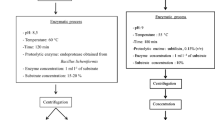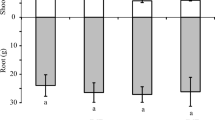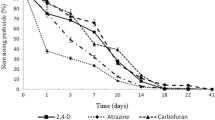Abstract
Biobeds provide a simple and cheap solution to reducing point-source contamination by pesticides from farm activities. In its original design, the Swedish biobed is a clay-lined pit in the ground filled with a biomixture of topsoil, peat and straw and covered with a grass layer. The straw stimulates the growth of lignin-degrading fungi and the formation and activity of ligninolytic enzymes which can degrade many different pesticides. Here we compared the behaviour of the chlorpyrifos pesticide in two biobeds of different composition: a Swedish biobed composed of 50%v vine straw, 25%v peat and 25%v Swedish soil; and an Italian biobed composed of 40%v vine straw, 40%v green compost and 20%v Italian soil. Microbial biomass was measured in the Italian biomix by the fumigation-extraction method. The microbial activity was estimated by measuring mineralisation of a synthetic lignin, 14C-de-hydrogenative polymerisate (14C-DHP) in the Swedish biomix. Microbial respiration was followed over time in both biomixes. Our results show that the chlorpyrifos half-lives were similar in both biomixes. The microbial biomass content was reduced by 25 and 50% with, respectively, 10 and 50 mg kg−1 chlorpyrifos in the Italian biomix. The respiration activity was affected only at 50 mg kg−1 chlorpyrifos in the Italian biomix. No effect was observed in the Swedish biomix despite the higher chlorpyrifos concentration of 100 mg kg−1. The mineralisation of 14C-DHP was not affected by the presence of chlorpyrifos in the Swedish biomix. These findings could be explained by the presence of chlorpyrifos-sensitive microorganisms in the Italian biomix and chlorpyrifos-resitant microorganisms in the Swedish biomix. The more robust microftora developed in the Swedish biomix may be explained by its lower nitrogen content, higher C/N ratio and lower pH, all of which are favourable for the development of lignin-degrading fungi and their activity. In Sweden more than 1000 biobeds are in practical use on farms and they have been shown to be efficient at reducing pesticide water-body contamination. The present study compares the capability of an Italian biomix for degrading pesticides to that shown by the Swedish original biomix in order to introduce this biological system for a sustainable Italian agriculture.
Similar content being viewed by others
References
Accinelli C., Screpanti C., Vicari A. (2005) Influence of flooding on the degradation of linuron, isoproturon and metolachlor in soil, Agron. Sustain. Dev. 25, 401–406.
Brinch U.C., Ekelund F., Jacobsen C.S. (2002) Method for spiking soil samples with organic compounds, Appl. Environ. Microb. 68, 1808–1816.
Carter A.D. (2000) How pesticides get into water and proposed reduction measures, Pestic. Outlook 11, 149–157.
Castillo M.d.P., Ander P., Stenström J. (1997) Lignin and manganese peroxidase activity in extracts from straw solid substrate fermentations, Biotechnol. Tech. 11, 701–706.
Castillo M.d.P, Ander P., Stenström J., Torstensson L. (2000) Degradation of the herbicide bentazon as related to enzyme production by Phanerochaete chrysosporium in a solid substrate fermentation system, World J. Microb. Biot. 16, 289–295.
Castillo M.d.P, von Wirén-Lehr S., Scheunert I., Torstensson L. (2001) Degradation of isoproturon by the white rot fungus Phanerochaete chrysosporium, Biol. Fert. Soils 33, 521–528.
Deacon J.W. (1983) Introduction to Modern Mycology, in: Wilkinson J.E (Ed.), Basic Microbiology, Vol. 7, second ed., Blackwell Scientific Publication, Oxford, p. 239.
Fait G., Nicelli M., Trevisan M., Capri E. (2004) A biological system of decontamination of water polluted with pesticides on farms, Inform. Agrar. 60, 43–45.
Fait G., Nicelli M., Fragoulis G., Trevisan M., Capri E. (2007) Reduction of point sources of pesticide from a vineyard farm, Environ. Technol., in press.
Laine M., Jorgensen K. (1996) Straw compost and bioremediated soil as inocula for the bioremediation of chlorophenol-contaminated soil, Appl. Environ. Microb. 62, 1507–1513.
Martinez-Toledo M.V., Salmeron V., Gonzalez-Lopez J. (1992) Effect of the insecticides methylpyrimifos and chlorpyrifos on soil microflora in an agricultural loam, Plant Soil 147, 25–30.
Pizzul L., Castillo M.d.P., Stenström J. (2006a) Characterization of selected actinomycetes degrading polyaromatic hydrocarbons in liquid culture and spiked soil, World J. Microb. Biot. 22, 745–752.
Pizzul L., Castillo M.d.P., Stenström J. (2006b) Effect of rapeseed oil on the degradation of PAH in soil by Rhodococcus wratislaviensis, In revision with International Biodeterioration & Biodegradation.
Racke K.D., Coats J.R., Titus K.R. (1988) Degradation of chlorpyrifos and its hydrolysis product, 3,5,6-trichloro-2-pyridinol, in soil, J. Environ. Sci. Heal. B 23, 527–539.
Rose S.C., Basford W.D., Carter A.D. (2003) On-farm bioremediation system to limit point source pesticide pollution, Proceeding of XII International Symposium on Pesticide Chemistry, Piacenza, Italy, June 2003, pp. 559–566.
Screpanti C., Accinelli C., Vicari A., Catizone P. (2005) Glyphosate and glufosinate-ammonium runoff from a corn-growing area in Italy, Agron. Sustain. Dev. 25, 407–412.
Sparling G.P., West A.W (1988) A direct extraction method to estimate soil microbial-C — Calibration insitu using microbial respiration and C-14-labeled cells, Soil Biol. Biochem. 20, 337–343.
Torstensson L. (2000) Experiences of biobeds in practical use in Sweden, Pestic. Outlook 11, 169–212.
Torstensson L., Castillo M.d.P. (1997) Use of biobeds in Sweden to minimize environmental spillages from agricultural spraying equipment, Pestic. Outlook 8, 24–27.
Vischetti C., Capri E., Trevisan M., Casucci C., Perucci P. (2004) Biomassbed: a biological system to reduce pesticide point contamination at farm level, Chemosphere 55, 823–828.
Vischetti C., Perucci P., Casucci C., Monaci E., Dumontet S. (2006) Biochemical parameter changes in urban-waste compost used as biofilter for pesticide decontamination, Int. J. Environ. An. Ch. 86, 195–205.
von Wirén-Lehr S., Castillo M.d.P, Torstensson L., Scheunert I. (2001) Degradation of isoproturon in biobeds, Biol. Fert. Soils 33, 535–540.
Author information
Authors and Affiliations
Corresponding author
About this article
Cite this article
Vischetti, C., Coppola, L., Monaci, E. et al. Microbial impact of the pesticide chlorpyrifos on Swedish and Italian biobeds. Agron. Sustain. Dev. 27, 267–272 (2007). https://doi.org/10.1051/agro:2007020
Accepted:
Issue Date:
DOI: https://doi.org/10.1051/agro:2007020




